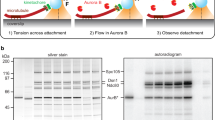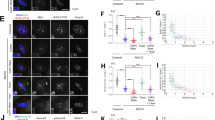Abstract
Proper partitioning of the contents of a cell between two daughters requires integration of spatial and temporal cues. The anaphase array of microtubules that self-organize at the spindle midzone contributes to positioning the cell-division plane midway between the segregating chromosomes1. How this signalling occurs over length scales of micrometres, from the midzone to the cell cortex, is not known. Here we examine the anaphase dynamics of protein phosphorylation by aurora B kinase, a key mitotic regulator, using fluorescence resonance energy transfer (FRET)-based sensors in living HeLa cells and immunofluorescence of native aurora B substrates. Quantitative analysis of phosphorylation dynamics, using chromosome- and centromere-targeted sensors, reveals that changes are due primarily to position along the division axis rather than time. These dynamics result in the formation of a spatial phosphorylation gradient early in anaphase that is centred at the spindle midzone. This gradient depends on aurora B targeting to a subpopulation of microtubules that activate it. Aurora kinase activity organizes the targeted microtubules to generate a structure-based feedback loop. We propose that feedback between aurora B kinase activation and midzone microtubules generates a gradient of post-translational marks that provides spatial information for events in anaphase and cytokinesis.
This is a preview of subscription content, access via your institution
Access options
Subscribe to this journal
Receive 51 print issues and online access
$199.00 per year
only $3.90 per issue
Buy this article
- Purchase on Springer Link
- Instant access to full article PDF
Prices may be subject to local taxes which are calculated during checkout




Similar content being viewed by others
References
Glotzer, M. The molecular requirements for cytokinesis. Science 307, 1735–1739 (2005)
Bement, W. M., Benink, H. A. & von Dassow, G. A microtubule-dependent zone of active RhoA during cleavage plane specification. J. Cell Biol. 170, 91–101 (2005)
Kalab P, Pralle A, Isacoff E. Y, Heald R & Weis K Analysis of a RanGTP-regulated gradient in mitotic somatic cells. Nature 440, 697–701 (2006)
Rappaport, R. Cytokinesis in Animal Cells (Cambridge Univ. Press, Cambridge, 1996)
Alsop, G. B. & Zhang, D. Microtubules continuously dictate distribution of actin filaments and positioning of cell cleavage in grasshopper spermatocytes. J. Cell Sci. 117, 1591–1602 (2004)
Violin, J. D. et al. A genetically encoded fluorescent reporter reveals oscillatory phosphorylation by protein kinase C. J. Cell Biol. 161, 899–909 (2003)
Lan, W. et al. Aurora B phosphorylates centromeric MCAK and regulates its localization and microtubule depolymerization activity. Curr. Biol. 14, 273–286 (2004)
Ruchaud S, Carmena M & Earnshaw W. C Chromosomal passengers: conducting cell division. Nature Rev. Mol. Cell Biol. 10, 798–812 (2007)
Zeitlin, S. G. et al. Differential regulation of CENP-A and histone H3 phosphorylation in G2/M. J. Cell Sci. 114, 653–661 (2001)
Su, T. T., Sprenger, F., DiGregorio, P. J., Campbell, S. D. & O’Farrell, P. H. Exit from mitosis in Drosophila syncytial embryos requires proteolysis and cyclin degradation, and is associated with localized dephosphorylation. Genes Dev. 21, 495–503 (1998)
Murata-Hori, M., Tatsuka, M. & Wang, Y. L. Probing the dynamics and functions of aurora B kinase in living cells during mitosis and cytokinesis. Mol. Biol. Cell 4, 1099–1108 (2002)
Gruneberg, U., Neef, R., Honda, R., Nigg, E. A. & Barr, F. A. Relocation of aurora B from centromeres to the central spindle at the metaphase to anaphase transition requires MKLP2. J. Cell Biol. 166, 167–172 (2004)
Wheatley, S. P. et al. CDK1 inactivation regulates anaphase spindle dynamics and cytokinesis in vivo. J. Cell Biol. 138, 385–393 (1997)
Meinhardt, H. & Greier, A. Pattern formation by local self-activation and lateral inhibition. Bioessays 22, 753–760 (2000)
Bishop, J. D. & Schumacher, J. M. Phosphorylation of the carboxyl terminus of inner centromere protein (INCENP) by the aurora B kinase stimulates aurora B kinase activity. J. Biol. Chem. 277, 27577–27580 (2002)
Yasui, Y. et al. Autophosphorylation of a newly identified site of aurora-B is indispensable for cytokinesis. J. Biol. Chem. 279, 12997–13003 (2004)
Hauf, S. et al. The small molecule hesperadin reveals a role for Aurora B in correcting kinetochore-microtubule attachment and in maintaining the spindle assembly checkpoint. J. Cell Biol. 161, 281–294 (2003)
Rosasco-Nitcher, S. E., Lan, W., Khorasanizadeh, S. & Stukenberg, P. T. Centromeric Aurora-B actvation requires TD-60, microtubules and substrate priming phophorylation. Science 319, 469–472 (2008)
Söderberg, O. et al. Direct observation of individual endogenous protein complexes in situ by proximity ligation. Nature Methods 3, 995–1000 (2006)
Canman, J. C. et al. Determining the position of the cell division plane. Nature 424, 1074–1078 (2003)
Wheatley, S. P. & Wang, Y.-L. Midzone microtubule bundles are continuously required for cytokinesis in cultured epithelial cells. J. Cell Biol. 135, 981–989 (1996)
Neef, R. et al. Phosphorylation of mitotic kinesin-like protein 2 by polo-like kinase 1 is required for cytokinesis. J. Cell Biol. 162, 863–875 (2003)
Obenauer, J. C., Cantley, L. C. & Yaffe, M. B. Scansite 2.0: proteome-wide prediction of cell signaling interactions using short sequence motifs. Nucleic Acids Res. 31, 3635–3641 (2003)
Durocher, D. et al. The molecular basis of FHA domain:phosphopeptide binding specificity and implications for phospho-dependent signaling mechanisms. Mol. Cell 6, 1169–1182 (2000)
Nguyen, A. W. & Daugherty, P. S. Evolutionary optimization of fluorescent proteins for intracellular FRET. Nature Biotechnol. 23, 355–360 (2005)
Shelby, R. D., Hahn, K. M. & Sullivan, K. F. Dynamic elastic behavior of α-satellite DNA domains visualized in situ in living human cells. J. Cell Biol. 135, 545–557 (1996)
Peters, U. et al. Probing cell-division phenotype space and Polo-like kinase function using small molecules. Nature Chem. Biol. 2, 618–626 (2006)
Acknowledgements
We thank: the Department of Biochemistry and Molecular Genetics, University of Virginia School of Medicine, for its support; D. Burke for many discussions; W. Lan for contributions to this manuscript; Y.-L. Wang (University of Massachusetts Medical School) for the aurora B-green fluorescent protein (aurora B-GFP) plasmid; H. Nakagawa (University of Tokyo) for the anti-MKLP-2 antibody; C. D. Allis (Rockefeller University) for the anti-phospho H3 serine 10 antibody; A. Newton (University of California San Diego) for the CKAR plasmid; A. North and the Rockefeller University Bioimaging facility. This work was supported by: the American Lung foundation (P.T.); the National Institutes of Health grants to T.M.K., P.T.S. and D.L.B.; a Francis Goulet Fellowship at Rockefeller University (M.A.L.); a National Institute of Child Health and Human Development T32 Training Grant ‘Cellular and Physiologic Mechanisms in Reproduction’ at the University of Virginia (B.G.F.); and the Pew Charitable Trust. E.A.F. is a Robert Blount Family Fellow of the Damon Runyon Cancer Research Foundation. We thank N. Kraut and Boehringer Ingelheim for hesparadin.
Author Contributions Development of the aurora B and Plk phosphorylation sensors, and FRET imaging and analysis, were done in the Kapoor laboratory by M.A.L. with E. A.F. B.G.F. performed immunofluorescence experiments. S. R.-N. and P.T. performed the kinase assays and P-LISA experiments, respectively. K.V.L. performed live imaging of aurora B-GFP. M.A.L. and B.G.F. wrote the paper.
Author information
Authors and Affiliations
Corresponding authors
Supplementary information
Supplementary Information
The file contains Supplementary Figures S1-S11 and Legends; Supplementary Methods; Supplementary Tables S1-S4; additional references and Supplementary Movies 1-9 Legends. (PDF 6741 kb)
Supplementary Movie 1
The file contains Supplementary Movie 1. YFP signal (SV1) and YFP/CFP emission ratio (SV2) from a cell expressing the centromere-targeted Aurora B sensor, with MAD2 depleted by RNAi. The video corresponds to the images in Fig. 1c. (AVI 133 kb)
Supplementary Movie 2
The file contains Supplementary Movie 2. YFP signal (SV1) and YFP/CFP emission ratio (SV2) from a cell expressing the centromere-targeted Aurora B sensor, with MAD2 depleted by RNAi. The video corresponds to the images in Fig. 1c. (AVI 133 kb)
Supplementary Movie 3
The file contains Supplementary Movie 3. YFP signal (SV3) and YFP/CFP emission ratio (SV4) from a cell expressing the chromatin-targeted Aurora B sensor. The video corresponds to the images in Fig. 2a. (AVI 277 kb)
Supplementary Movie 4
The file contains Supplementary Movie 4. YFP signal (SV3) and YFP/CFP emission ratio (SV4) from a cell expressing the chromatin-targeted Aurora B sensor. The video corresponds to the images in Fig. 2a. (AVI 277 kb)
Supplementary Movie 5
The file contains Supplementary Movie 5. DIC (SV5), YFP (SV6), and YFP/CFP emission ratio (SV7) during monopolar anaphase. The video corresponds to the images in Fig. 4a. (AVI 2141 kb)
Supplementary Movie 6
The file contains Supplementary Movie 6. DIC (SV5), YFP (SV6), and YFP/CFP emission ratio (SV7) during monopolar anaphase. The video corresponds to the images in Fig. 4a. (AVI 385 kb)
Supplementary Movie 7
The file contains Supplementary Movie 7. DIC (SV5), YFP (SV6), and YFP/CFP emission ratio (SV7) during monopolar anaphase. The video corresponds to the images in Fig. 4a. (AVI 371 kb)
Supplementary Movie 8
The file contains Supplementary Movie 8. Aurora B-GFP (SV8) and DIC (SV9) during monopolar anaphase. The video corresponds to the images in Fig. S11c-d. (AVI 3258 kb)
Supplementary Movie 9
The file contains Supplementary Movie 9. Aurora B-GFP (SV8) and DIC (SV9) during monopolar anaphase. The video corresponds to the images in Fig. S11c-d. (AVI 6341 kb)
Rights and permissions
About this article
Cite this article
Fuller, B., Lampson, M., Foley, E. et al. Midzone activation of aurora B in anaphase produces an intracellular phosphorylation gradient. Nature 453, 1132–1136 (2008). https://doi.org/10.1038/nature06923
Received:
Accepted:
Published:
Issue Date:
DOI: https://doi.org/10.1038/nature06923
This article is cited by
-
CENP-E activation by Aurora A and B controls kinetochore fibrous corona disassembly
Nature Communications (2023)
-
A gene-encoded FRET fluorescent sensor designed for detecting asymmetric dimethylation levels in vitro and in living cells
Analytical and Bioanalytical Chemistry (2023)
-
Permission to pass: on the role of p53 as a gatekeeper for aneuploidy
Chromosome Research (2023)
-
A mitotic chromatin phase transition prevents perforation by microtubules
Nature (2022)
-
Membrane and organelle dynamics during cell division
Nature Reviews Molecular Cell Biology (2020)
Comments
By submitting a comment you agree to abide by our Terms and Community Guidelines. If you find something abusive or that does not comply with our terms or guidelines please flag it as inappropriate.



